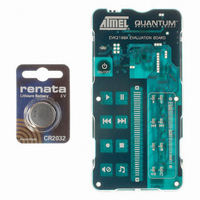EVK2160A Atmel, EVK2160A Datasheet - Page 13

EVK2160A
Manufacturer Part Number
EVK2160A
Description
KIT EVAL FOR AT42QT2160-MMU
Manufacturer
Atmel
Series
Quantum, QTouch™r
Specifications of EVK2160A
Sensor Type
Touch, Capacitive
Sensing Range
8 Buttons/Keys, Slider
Interface
I²C
Voltage - Supply
1.8 V ~ 5.5 V
Embedded
No
Utilized Ic / Part
AT42QT2160
Silicon Manufacturer
Atmel
Silicon Core Number
AT42QT2160-MMU
Kit Application Type
Sensing - Touch / Proximity
Application Sub Type
Capacitive Touch
Kit Contents
Board CD Docs
Rohs Compliant
Yes
Lead Free Status / RoHS Status
Lead free / RoHS Compliant
Sensitivity
-
Lead Free Status / Rohs Status
Supplier Unconfirmed
Other names
427-1141
Available stocks
Company
Part Number
Manufacturer
Quantity
Price
Company:
Part Number:
EVK2160A
Manufacturer:
Atmel
Quantity:
135
4.15
4.16
4.17
9502A–AT42–07/08
Spread Spectrum Acquisitions
Detection Integrator
Sleep
QT2160 uses spread-spectrum burst modulation. This has the effect of drastically reducing the
possibility of EMI effects on the sensor keys, while simultaneously spreading RF emissions. This
feature is hard-wired into the device and cannot be disabled or modified.
Spread spectrum is configured as a frequency chirp over a wide range of frequencies for robust
operation.
See also
The device features a detection integration mechanism, which acts to confirm a detection in a
robust fashion. A per-key counter is incremented each time the key has exceeded its threshold
and stayed there for a number of acquisitions. When this counter reaches a preset limit the key
is finally declared to be touched.
For example, if the limit value is 10, then the device has to exceed its threshold and stay there
for 10 acquisitions in succession without going below the threshold level, before the key is
declared to be touched. If on any acquisition the signal is not seen to exceed the threshold level,
the counter is cleared and the process has to start from the beginning.
The device operates on a fixed 16ms cycle time basis. The device will perform a set of
measurements and then sleep for the rest of the cycle to conserve power.
There are two user-configurable sleep modes; Low Power (LP) mode and SLEEP mode.
The LP setting (see
touches and is set to be a long time period. This will determine how often the device wakes up to
do drift compensation. It also determines the maximum response time to the first touch after
inactivity.
When a valid touch is registered, the device enters minimum cycle time (16ms) for a faster
response to key touch and object operation. The device will stay in this mode if it continues to
see keys being touched and released. There is a user-selectable inactivity timeout i.e. the
awake timeout.
The measurement period needs to be shorter than the 16ms fixed cycle time for optimum
operation. If the measurement time exceeds the 16ms fixed cycle time, a CYCLE OVERRUN bit
is set in the general status register. The QT2160 will still operate if the 16ms fixed cycle time is
exceeded, but the timing for the timed parameters, e.g. drift compensation negative recalibration
time out etc. will slightly change.
A low power setting of zero causes the device to enter an ultra-low power mode (SLEEP), where
no measurements are carried out. SLEEP mode also stops the internal watchdog timer, so that
the part is totally dormant, and current drain is <2µA. The PWM function will not be carried out
during SLEEP, therefore it is recommended driving the GPIOs/GPOs to known states before
entering SLEEP mode.
The QT2160 wakes from SLEEP mode if there is an address match on the
hardware reset on the RST pin or an LP mode is set. If the Wake option is set for the dedicated
GPIO inputs, then the QT2160 will trigger the CHANGE line if a change in status (either positive
or negative going edge) of the respective GPIO is detected, in SLEEP mode.
Section 4.2 on page
Section 4.2 on page
5.
5) is used for conserving power when there are no
AT42QT2160
I
2
C
-compatible bus, a
13













